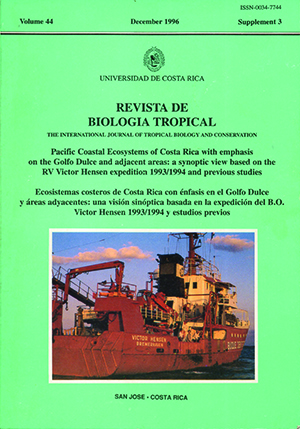Abstract
During the first cruise leg with the RY Victor Hensen to tile Pacific coast of Costa Rica in December 1993 (end of the rainy season) the custacean fauna found in the demersal collections revealed an unexpected species richness and biomass. The Crustacea collections were analyzed qualitatively and quantitatively during the fourth leg (February 1994, dry season) in the three study areas Golfo Dulce (GD). Bahía Coronado in the Sierpe-Térraba-estuary (ST) and Golfo de Nicoya (GN). Qualitative data were available (or comparison from the first leg in december 1993. A total of 24 beamtrawl and ten ottertrawl sample collections were done on an area of 860.000 m2 yielding a total of 119 species with a biomass of 37.8 kg (10275 specimens). Despite the smaller area covered by the beamtrawl, it collected a higher number of species and more biomass than the ottertrawl due to the smaller mesh size (0.8 cm). Judging from the shape of the species-per-area-curves, the crustacean fauna appeared representatively sampled for the study area. As compared with the GN (biomass 0.36 g ± 0.26, SR = 97) and the ST (0.41 g ± 0,27, SR = 59) and according to the results of the log-series-plots constructed from the abundance data. the GD seems to be a depauperated area with significantly lower biomass (0.05 g ± 0,07) and species richness (45 sp.). No crustaceans were found in the center of the deep basin of the GD but parts of the interior gulf with adjacent mangrove areas seem to be important as nursery area for some commercially important penacid shrimp species. The ST-estuary revealed the highest mean species number per station in the whole study area, but the GN had the highest total number of species. Biomass seems to be regularly distributed and not depth-depending within the GN. while species abundance varies clearly, confirming previous results. In contrast. abundance and biomass correlated well in the ST. Based on the results of the multivariate analysis, seven station groups of particular species assemblages can be distinguished in the study areas. Despite a high variability between stations in abundance and biomass, the following four areas of characteristic species assemblages can be identified which are also confirmed by an independent study on demensal fishes: (I) the interior part of the GN, characterized by juvenile shrimps (Sicyonia disdorsalis, Trachypenaus fuscina), several patchily distributed anomurans, brachyurans and other predator species like portunids (especially Portunus asper) and pre-adult stomatopods (Squilla spp.); (2) the exterior part of the GN with high amounts of caridean (Pantomus affinis, Plesionika spp.) and penaeid shrimps (Sicyonia picta, Solenocera mutator), the highly abundant Iliacantha hancocki and some specimens of the stomatopod Hemisquilla stylifera and the deep water ponunid Portunus iridiscens; (3) a transition zone between 60 and 120 m water depth with a heterogeneous faunal composition, located in the ST and cast of Isla Tortugas in the GN. and (4) the oxygen-depleted shelf edge area, dominated by the galatheid Pleuroncodes monodon. Mass occurrence of this species takes place off the GO and to a lesser extent off the ST-estuary, associated with high numbers of Solenocero spp. There seems to be a general trend of species groupings along abiotic gradients (depth, temperature, oxygen saturation) interrupted by small-scale variations in habitat type, current regime, food availability and other factors not identified in this study. Neither total abundance and biomass nor biotic summary parameters like diversity, dominance or species richness correlated well with the abiotic factors measured during this survey.##plugins.facebook.comentarios##

This work is licensed under a Creative Commons Attribution 4.0 International License.
Copyright (c) 1996 Revista de Biología Tropical
Downloads
Download data is not yet available.


